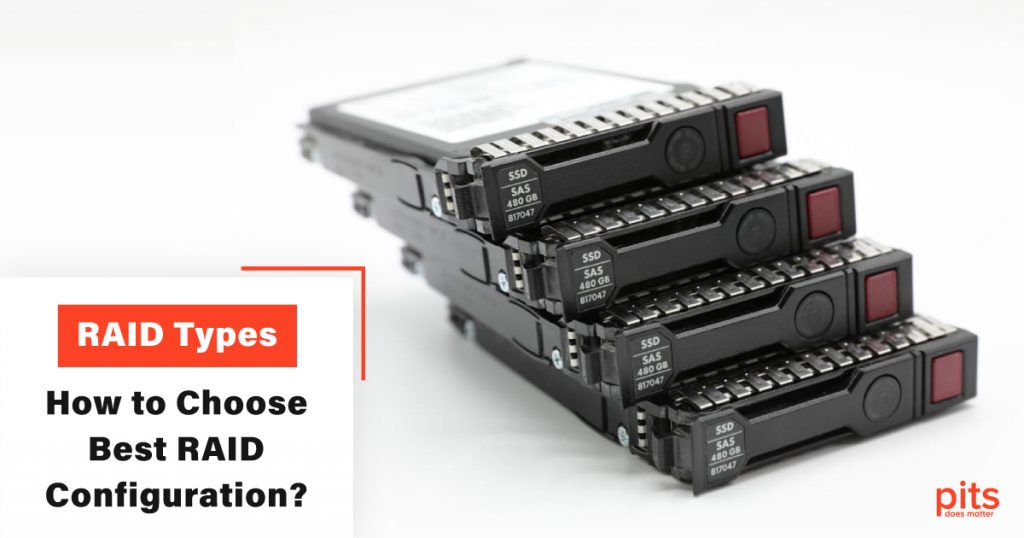RAID (Redundant Array of Independent Disks) is a technology used for data storage and protection in computer systems. There are different types of RAID, each with its own unique features, benefits, and drawbacks.
What is RAID Array - RAID Definition
RAID is a data storage technology that combines multiple physical disk drives into a logical unit to improve data reliability and performance. It uses various techniques such as mirroring, striping, and parity to achieve redundancy and data protection.
By distributing data across multiple disks, RAID also provides increased read/write speed and fault tolerance in case of disk failures. RAID can be implemented through hardware or software, and there are several levels of RAID each with its own characteristics and benefits.
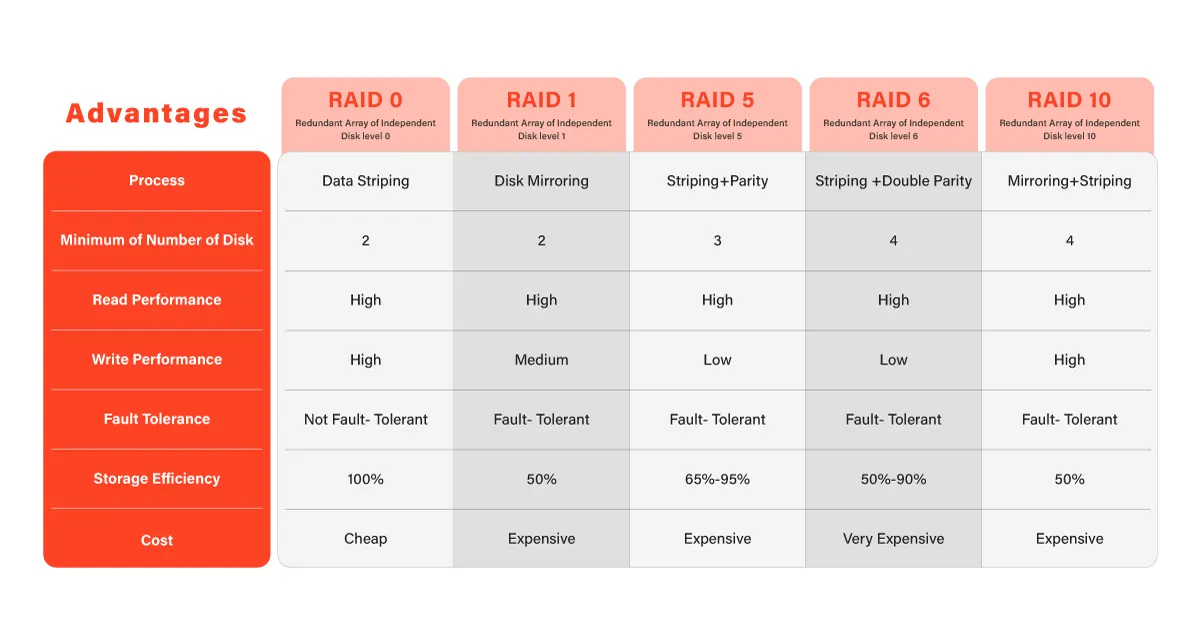
RAID 0 Array
RAID 0 is a popular choice for users who require fast data transfer rates for applications such as video editing and gaming. By splitting data across multiple disks, RAID 0 increases the data transfer rate and improves overall system performance. Since the data is striped across the disks, each drive can be read and written to simultaneously, which reduces the overall access time.
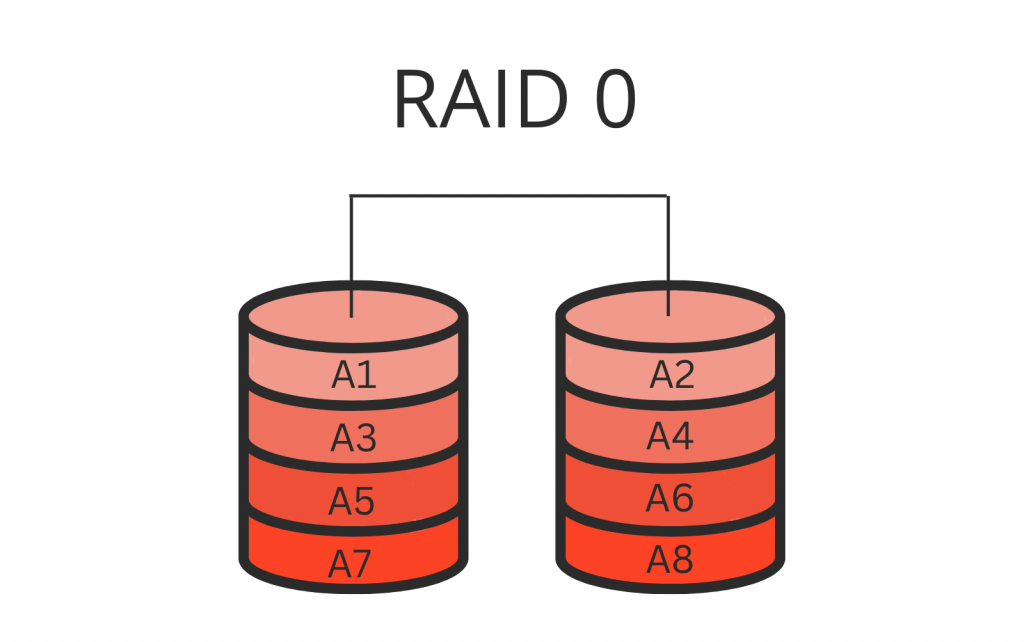
However, one drawback of RAID 0 is that it does not provide redundancy. With no mirroring or parity data to recover lost data, all data is lost if one of the disks fails. The risk of data loss makes RAID 0 a less reliable option for critical applications that require data redundancy.
It is important to note that RAID 0 should never be used for storing important or irreplaceable data, as it offers no protection against data loss due to drive failure.
Additionally, RAID 0 does not provide any advantages for random access time, which may not make it suitable for applications such as databases that require fast read/write speeds.
Overall, RAID 0 is best suited for applications where performance is the primary concern and where data loss is not a significant risk, such as video editing, gaming, or non-critical data storage. RAID 0 can be a cost-effective way to improve system performance and can be an excellent option when used appropriately. However, it is essential to consider the potential risks of data loss before implementing RAID 0 as a storage solution.
RAID 1 Array
RAID 1 is a popular choice for users who require high data redundancy and reliability. By creating an exact copy of data on two or more drives, RAID 1 provides redundancy that ensures data availability in case of a single drive failure. In RAID 1, data is written identically to two or more drives, which makes it an effective solution for applications that require high availability and reliability.
One advantage of RAID 1 is its excellent read performance since data can be read from any drive. However, write performance can be slower since data must be written to multiple drives simultaneously. Since each drive has a complete copy of the data, the read performance is improved as multiple drives can be read in parallel.
Another benefit of RAID 1 is that it is straightforward to implement and does not require any specialized hardware or software.

This makes it an attractive option for small businesses or individuals who need data redundancy but do not want to invest in complex storage solutions.
One disadvantage of RAID 1 is that it is less efficient regarding storage capacity since data is mirrored across all drives. This means that the total storage capacity of the array is equal to the capacity of one of the drives. Additionally, RAID 1 is more expensive than other RAID types since it requires more drives to achieve redundancy.
Overall, RAID 1 is an excellent option for applications that require high availability and data redundancy. It is simple to implement and provides excellent read performance, making it a popular choice for small businesses and individuals.
However, it is essential to consider the additional cost and storage capacity implications when choosing RAID 1 as a storage solution.
RAID 5 Array
RAID system 5 is a popular choice for users who require high performance and data redundancy. It is similar to RAID 0 as it uses striping to improve performance but also includes parity data to provide redundancy.
In RAID 5, data is split across multiple drives and parity information is used to recover lost data in case of drive failure. RAID 5 can tolerate the loss of one drive without losing data, making it a highly reliable and efficient storage solution.
One advantage of RAID 5 is that it provides a good balance of performance, storage capacity, and data redundancy. Since data is striped across multiple drives, RAID 5 can provide high read and write performance.
The parity data provides redundancy, ensuring that data remains available in case of drive failure. Additionally, RAID 5 is more efficient in terms of storage capacity than RAID 1, as it only requires one additional drive for parity data.
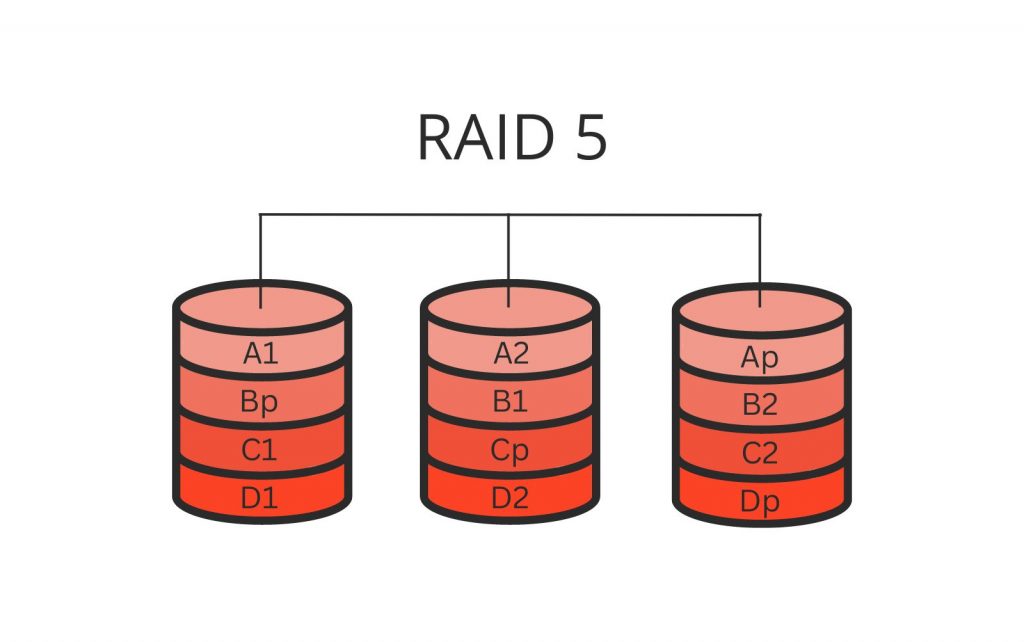
However, one potential drawback of RAID 5 is that it can be vulnerable to data loss during drive rebuilds. During the rebuild process, which is necessary when replacing a failed drive, the system has to recalculate the parity information for the new drive. This can take a long time, and during this time, the array is vulnerable to further drive failures. To mitigate this risk, it is essential to have a backup solution in place.
Overall, RAID 5 is a reliable and efficient storage solution that provides a good balance of performance and data redundancy. It is a popular choice for applications that require high read and write performance and data reliability, such as databases or file servers. However, it is essential to consider the potential risks of data loss during drive rebuilds and to have a backup solution in place to mitigate this risk.
RAID 6 Array
RAID 6 is a high-performance storage solution that provides an additional layer of redundancy compared to RAID 5. In RAID 6, data is striped across multiple drives, and parity data is used to provide redundancy. However, unlike RAID 5, RAID 6 has an additional parity block, which allows it to recover data in case two drives fail simultaneously.
The additional parity block in RAID 6 provides a significant advantage over RAID 5 in terms of data reliability. With two parity blocks, RAID 6 can withstand the failure of up to two drives in the array without losing data.
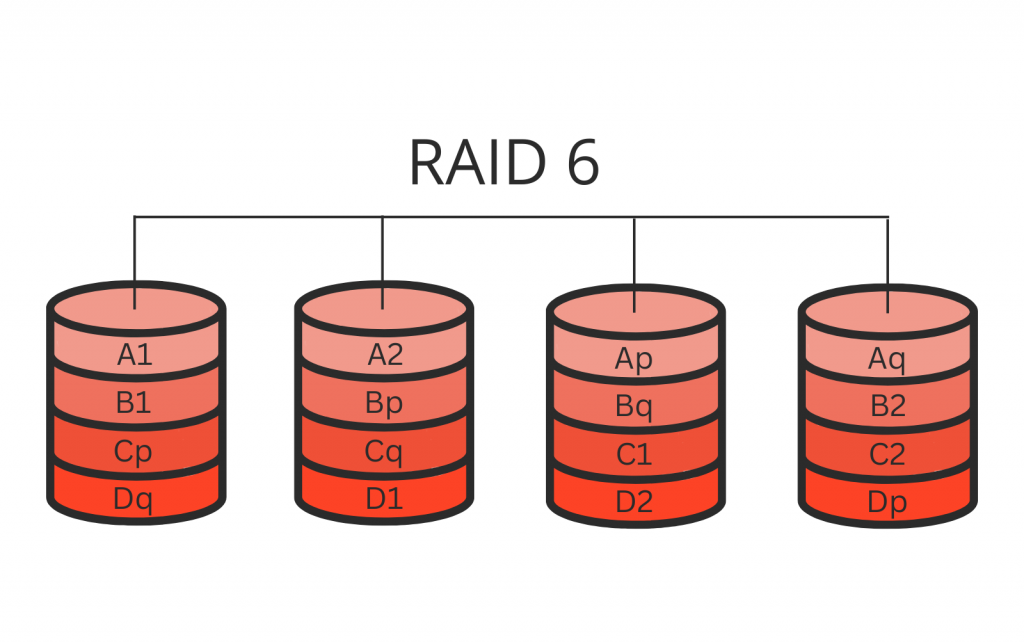
This makes it an ideal solution for high-end applications that require maximum data reliability, such as large-scale databases or data centers.
Like RAID 5, RAID 6 also provides high read and write performance since data is striped across multiple drives.
However, because of the additional parity block, RAID 6 requires more processing power than RAID 5, which can lead to slightly lower performance.
One potential drawback of RAID 6 is that it requires a minimum of four drives to implement, and it is less storage-efficient than RAID 5.
Since RAID 6 has two parity blocks, it requires two additional drives to provide redundancy compared to RAID 5’s one additional drive. This means that RAID 6 has a higher cost per terabyte of storage than RAID 5.
Overall, RAID 6 is an excellent option for applications that require maximum data reliability and redundancy. Its additional parity block provides an extra layer of protection against simultaneous drive failures, making it ideal for high-end applications that cannot tolerate any data loss. However, its higher cost and lower storage efficiency compared to RAID 5 may make it less suitable for some applications.
RAID 10 Array
RAID 10, also known as RAID 1+0, is a combination of RAID 1 and RAID 0. It provides high levels of both performance and redundancy, making it an ideal solution for applications that require both.
In RAID 10, data is first mirrored across pairs of drives, similar to RAID 1. Every data block is written to two drives simultaneously, providing redundancy in case one drive fails. Then, the mirrored pairs are striped together, like RAID 0, to improve performance.
This striping allows for data to be read and written across multiple drives simultaneously, increasing read and write speeds.
RAID 10 is considered one of the most robust RAID levels because it provides both redundancy and performance benefits.
In the event of a drive failure, the system can continue to operate without any interruption because the data is still available on the mirrored drive.
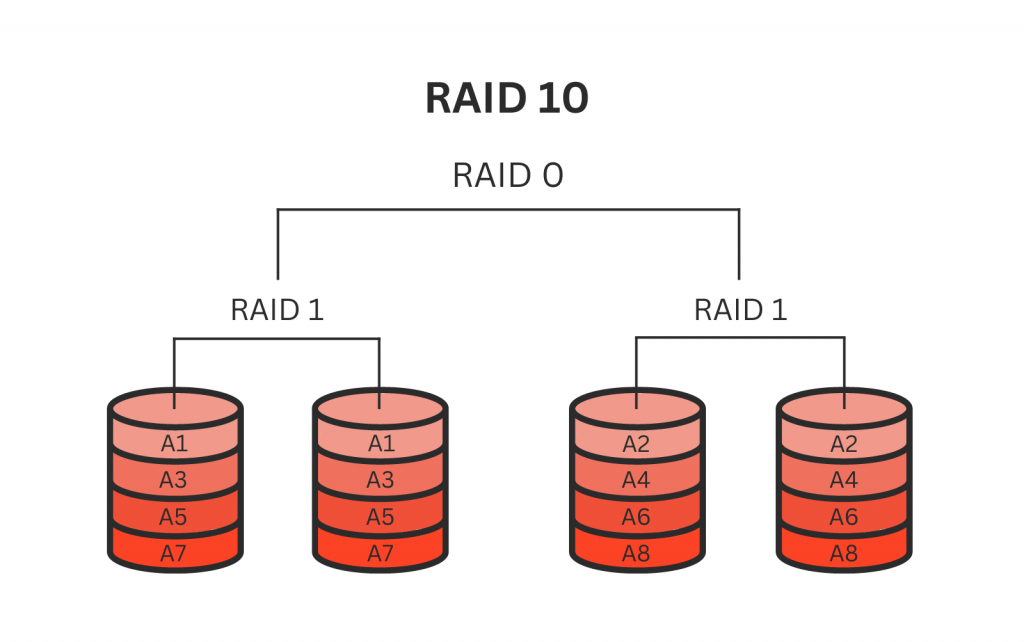
This makes RAID 10 an excellent choice for critical applications that cannot afford any downtime, such as large-scale databases or web servers. One potential disadvantage of RAID 10 is that it requires a minimum of four drives to implement. This can make it more expensive and less storage-efficient than other RAID configurations that require fewer drives.
Overall, RAID 10 is a highly recommended RAID level for those who require a combination of high performance and redundancy. Its combination of mirroring and striping provides both protection against data loss and improved performance, making it an excellent choice for critical applications.
RAID Levels Explained - Which to Choose?
Choosing the right RAID storage type for your needs requires careful consideration of several factors, including storage requirements, data protection needs, and performance goals. For example, if you prioritize performance over data redundancy, RAID 0 may be your best choice. However, if data protection is critical, RAID 1 or 6 may be better.
RAID 5 offers a good balance between performance and data protection, while RAID 10 provides both high performance and robust data redundancy. Ultimately, the choice of RAID level will depend on your specific needs and budget. It’s essential to evaluate the available options and consult with an expert to determine the most suitable RAID configuration for your use case.
Frequently Asked Questions
What is RAID, and what are the different RAID levels?
RAID stands for Redundant Array of Inexpensive Disks, and it is a technology that combines multiple physical disk drives into a logical unit for better data reliability, availability, and performance. There are several RAID levels, including RAID 0, RAID 1, RAID 5, RAID 6, and RAID 10, each with its own characteristics and benefits.
Which RAID level is best for data redundancy?
RAID levels that offer data redundancy include RAID 1, RAID 5, RAID 6, and RAID 10. RAID 1 provides mirroring, while RAID 5 and 6 use parity to protect against data loss due to disk failure. RAID 10 combines striping and mirroring to provide both high performance and data redundancy.
Which RAID level is best for performance?
RAID 0 is best for performance, as it provides striping without any redundancy. RAID 5 and RAID 6 offer a good balance between performance and data redundancy, while RAID 10 provides high performance and data redundancy.
Can I mix different types of disks in a RAID array?
It depends on the RAID level. Some RAID levels, such as RAID 0 and RAID 1, can use different types and sizes of disks, while others, such as RAID 5 and RAID 6, require disks of the same size and speed. Mixing different types of disks can result in degraded performance or data loss.
Can I change the RAID level of an existing array?
Converting the RAID level of an existing array is possible but can be complicated and risky. It typically involves backing up the data, destroying the array, reconfiguring the disks, and restoring the data. It’s recommended to consult with an expert before attempting to change the RAID level of an existing array.
